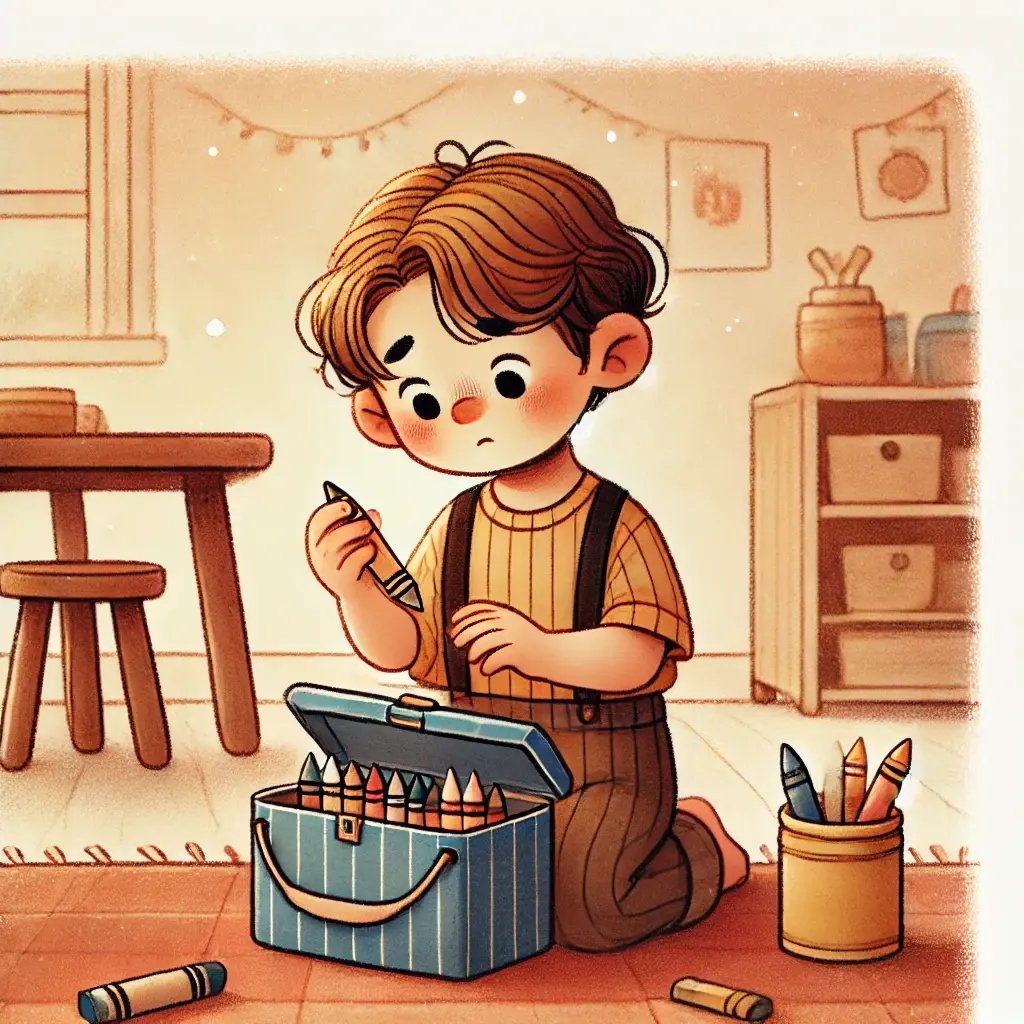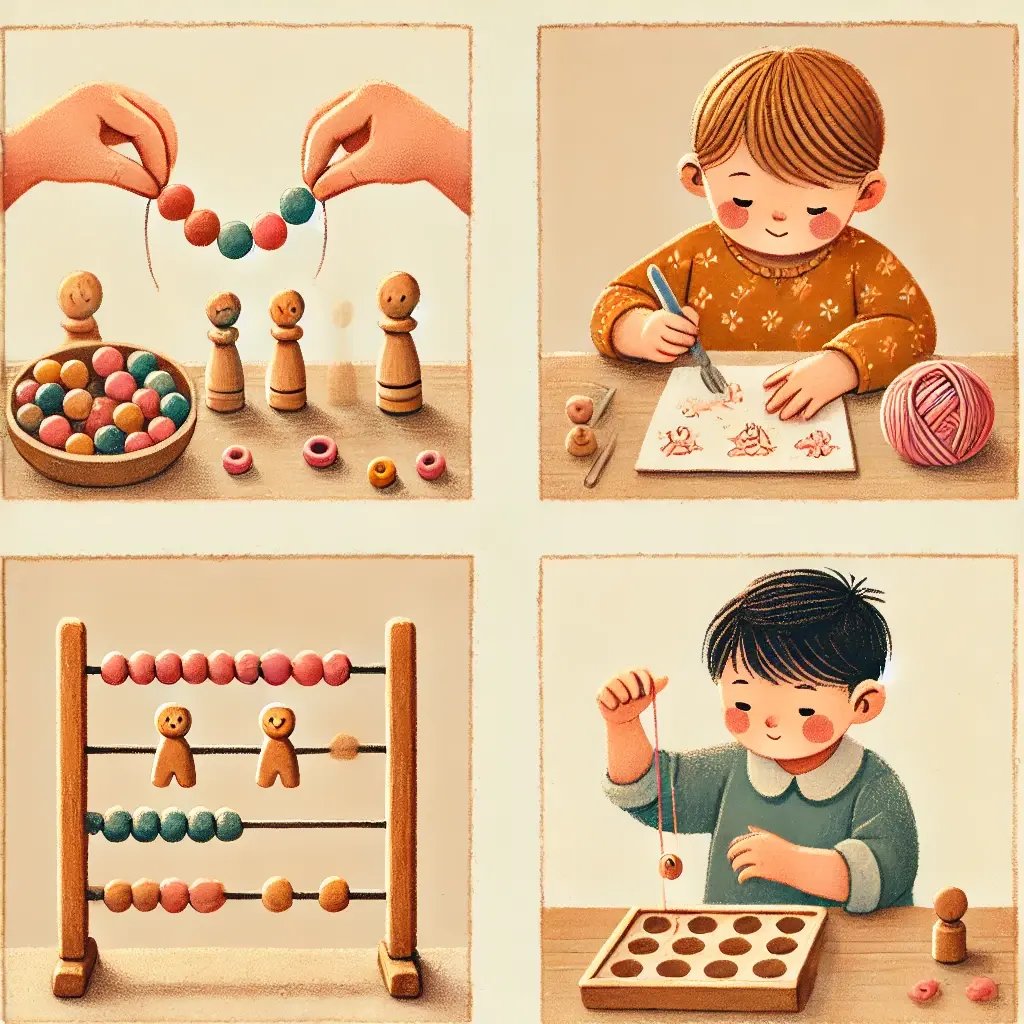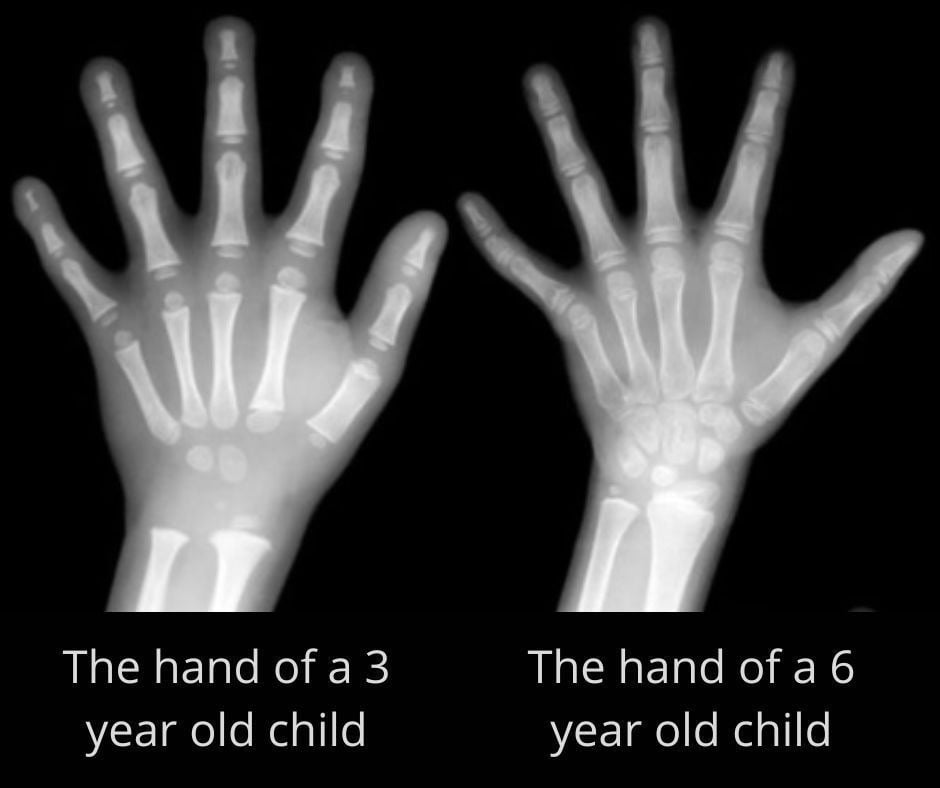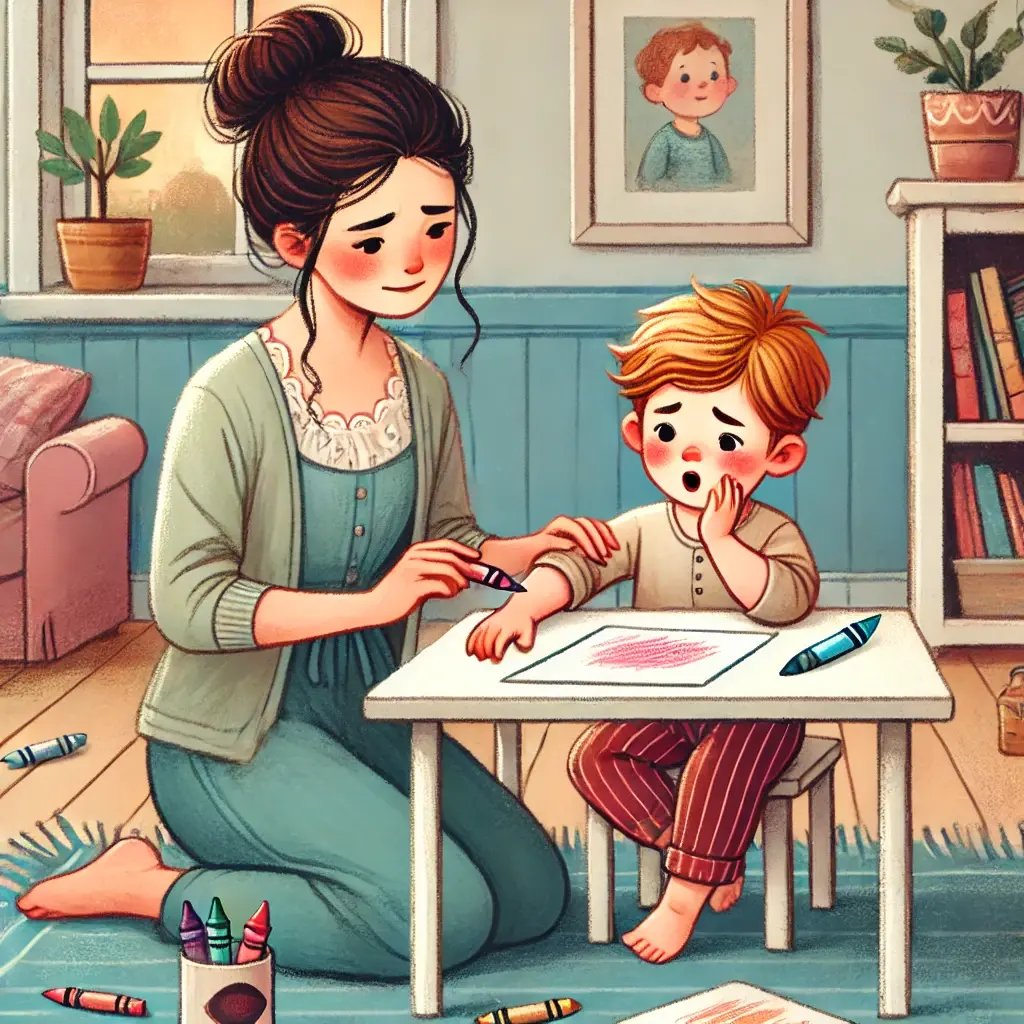In this blog post, I aim to discuss fine motor skills for preschool-aged children and explain how we incorporate them into the free homeschool preschool curriculum, Ready for Kindergarten and Beyond.
Why are fine motor skills necessary for preschoolers?

Fine motor skills are essential for children to learn before they start kindergarten. They are needed to open and close lunchboxes, put papers into a folder, write, color, and draw. Writing, coloring, and drawing require a tripod grasp of a writing tool. It can be difficult for undeveloped hands to manage this advanced grasp.
There are many skills involved in holding a pencil or crayon and writing with ease for an extended period.
But don’t worry, we’re here to help.
Fine motor skills examples for preschoolers

We approach fine motor skills by breaking down the different muscle groups and the various activities that must be coordinated together for a child to be able to write. Then we break those down into categories of exercises. Then, at the bottom of this article, you’ll find a detailed list of fine motor skills activities for 3-5-year-olds that work on each of these individual areas:
- Bilateral Hand Coordination
- In-hand Manipulation
- Hand-Eye Coordination
- Precision
- Finger Isolation
- Wrist Extension and Stability
- Open Thubm Web Space
- Grasps (gross grasp, spherical grasp, pincer grasp, tripod grasp)
All of these things work together to give your child the skills that they need to be able to write.
What we do is weave them into the curriculum, where your child practices activities in at least four of these different areas every week. Then, gradually, towards the end, after your child has had a chance to build muscle strength, coordination, hand-eye coordination, and bilateral hand coordination for several weeks, we begin to work on those more advanced grips, like the tripod grasp, that they will need to hold a pencil.
The importance of core strength in developing fine motor skills

Core strength is quite important for fine motor skills, and we often overlook the connection between the two, but they are indeed related. Sitting in a chair at a desk or a table for any length of time while writing does require tremendous core and shoulder strength. This is why we often see children complain about these activities.
They may not realize why they don't want to do this or why it's uncomfortable, but it often has to do with the fact that they haven't developed the necessary muscles and strength to do it comfortably.
You can help them with that by giving them the opportunity to engage in a wide variety of exercises that will help build that strength and make it more comfortable for them to do that.
Outdoor and unstructured play

A significant part of developing core strength in preschoolers involves outdoor play activities, such as playing on playgrounds, riding bikes, running, playing baseball, kicking a ball, and throwing a ball.
All of these factors contribute to your child's development of the fine motor skills necessary for writing, so ensure they receive plenty of outdoor playtime.
During outdoor playtime, they also engage in a variety of fine motor exercises. They pick up tiny pebbles on the ground and play in the sand or dirt with their hands. All of that lends itself to them exercising their core muscles and hand muscles to be ready to write when it's time to do that.

Unstructured play is another fantastic way to develop these skills. As they build with blocks and Legos or help you stir cookie dough in the kitchen, all of these more unstructured activities are also fantastic practice for building these muscles.
Preschool-aged children’s hand development
This is very interesting. If you compare an X-ray of a preschool child's hand with one of a 6-year-old's, you'll notice that they appear quite different.

Image source: When Should Children be able to Write? - Gavin McCormack
Little children's hands are not developed enough. They lack muscle and bone structure. You'll notice the differences in the bones of a child who's just a few years older. Therefore, the little children lack the physical hand structure necessary to write comfortably for extended periods of time.

And this is often why you see young children who have very little writing stamina. I want you to know that that is entirely normal. You often hear young children, when asked to complete a worksheet or color a coloring page, say that they're tired, that they want to stop before finishing, or that their hand hurts. And a lot of times, I think parents think that this is an excuse, “They don't want to do the activity”, but I would encourage you to believe them, and usually, when they say their hand hurts, it actually does.
How to improve fine motor skills
The best approach to this is through incremental, small amounts of practice, done frequently. That's why we offer you the activities below. First of all, you have a choice of activities to practice various things. Your child may enjoy one more than another. That way, you can zero in on those activities that they really engage with and want to have some sustained practice with to help build those muscles.
That always helps when they enjoy the activity.
And then you've got to make sure that you're selecting activities from those wide ranges of skills so that they're not practicing just one muscle group, but they're practicing a variety of muscle groups. And that's how we've incorporated it into the Ready for Kindergarten and Beyond curriculum, so that each week, you can select from a range of activities to exercise various muscles and build the stamina necessary for writing.

All of this practice goes a long way in preparing your child for kindergarten, where they can complete worksheets and coloring pages with comfort, without it bothering them to sit at a table or desk for a certain amount of time. They will be able to hold a pencil correctly and complete the assigned task without encountering those problems.
Now that you have a better understanding of how we approach fine motor skills, you'll be better prepared to select activities that work best for your child and your schedule.
Fine motor activities for preschoolers
Bilateral Hand Coordination
The ability to use both hands together, or use one hand as a stabilizer and the other as a manipulator.
Activities:
- Stabilizing paper with one hand while coloring or cutting with the other,
- Holding a straw while inserting a pipe cleaner into it,
- Spreading butter on bread,
- Popping bubbles with both hands,
- Tossing a ball from one hand to another and back again,
- Threading or lacing activities like lacing cards or stringing beads,
- Tying shoes,
- Putting papers in a folder,
- Zipping zippers.
In-hand Manipulation
The ability to manipulate objects within the hand. Includes mobility, shift, and rotation activities.
Activities:
- Moving a coin from the palm to the fingertips to insert it in a slot,
- Moving cereal pieces from palm to fingertips to eat them,
- Manipulating a button with fingertips to fit it into the buttonhole,
- Rolling a crayon in fingertips,
- Turning a pencil around to use the eraser,
- Tightening or loosening a bottle cap,
- Turning a die over in one hand to find a specific side,
- Sharpening a pencil with a hand-sharpener,
- Rotating a puzzle piece with one hand to put it in its proper place
Hand-Eye Coordination
The ability to coordinate what your hands are doing with what your eyes see to achieve the desired result.
Activities:
- Playing catch,
- Putting together a puzzle,
- Having a pillow fight,
- Playing T-ball,
- Planting seeds,
- Buttoning buttons or snapping snaps,
- Brushing one’s hair,
- Holding a book while turning pages,
- Coloring in the lines,
- Pouring water or sand into a cup or container,
- Tossing bean bags into baskets,
- Bowling or skittles,
- Placing caps on markers or glue sticks
Precision
The ability to make fine movements in a controlled manner.
Activities:
- Opening scissors a small amount in order to precisely cut curved lines,
- Picking up small items with tweezers,
- Threading embroidery thread into a large plastic needle,
- Placing stickers in a sticker book,
- Using a single-hole punch to punch out dots precisely,
- Using a syringe or eye dropper for an art project,
- Folding origami,
- Maze activities,
- Tracing activities,
- Putting pegs in a pegboard,
- Stacking cards neatly,
- Using glue precisely for an art project.
Finger Isolation
The ability to willfully move each finger independently of the others.
Activities:
- Playing Where is Thumbkin or other finger games,
- Typing on a keyboard,
- Playing a piano, recorder, or another musical instrument requiring finger isolation,
- Practicing sign language (such as the alphabet),
- Rolling small balls of clay or Play-Doh between thumb and forefinger,
- Spraying a spray bottle with just a couple of fingers,
- Spinning a coin,
- Shooting marbles,
- Finger painting crafts.
Wrist Extension and Stability
The ability to hold your wrist in a functional position while working and stabilize your wrist while manipulating objects with your fingers.
Activities:
- Poking toothpicks into an overturned colander,
- Combing hair,
- Carrying a tray on an extended palm,
- Writing, painting, or coloring on a vertical surface,
- Shaking rattle toys or musical instruments,
- Cleaning a mirror or window,
- Playing with sock puppets,
- Playing baseball, tennis, badminton, etc.
Open Thumb Web Space
The ability to rotate the thumb to the necessary position for the tip of the thumb and index fingertip to touch in opposition (ie. Make the “OK” sign).
Activities:
- Picking up tiny objects with fingertips,
- Shuffling cards,
- Closing Ziplock bags,
- Using clothespins,
- Pulling push pins out of the pegboard,
- Playing with a Lite-Brite,
- Pinching Play-Doh.
Grasps
Gross (Cylindrical) Grasp
Squeezing the entire hand shut around an object.
Activities:
- Holding the handle of a suitcase or lunchbox,
- Gripping a broom handle,
- Gripping a baseball bat,
- Holding an ice cream cone,
- Pushing or pulling toys with handles,
- Singing “row, row, row your boat” while rowing with a broom handle,
- Pouring from a pitcher,
- Playing tug-of-war,
- Holding the handles of a bicycle,
- Removing caps from markers or glue sticks.
Spherical Grasp
Where the hand curves to hold a round or spherical object.
Activities:
- Gripping, throwing, and catching balls of various sizes,
- Gripping and manipulating spherical fruit such as apples or peaches,
- Gripping and manipulating large wooden beads or spherical building blocks.
Pincer Grasp
Pad-to-pad grip of the thumb and index finger.
Activities:
- Plucking fuzz off clothing,
- Self-feeding dry cereal or other small snacks,
- Peeling tape,
- Picking up tiny objects such as Perler beads or sequins,
- Holding the string while stringing beads,
- Pulling pom-poms out of the center of a whisk,
- Sorting small objects into egg cartons or ice cube trays,
- Pinching Play-Doh or clay.
Tripod Grasp
Gripping using the pads of the index and middle finger, along with the thumb.
Activities:
- Writing with a pencil,
- Coloring with crayons or markers,
- Sprinkling glitter,
- Pushing toothpicks into a spice container,
- Eating with utensils,
- Positioning washers onto screws.